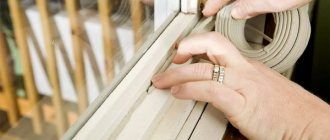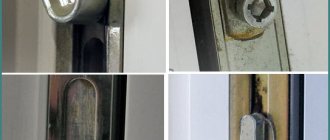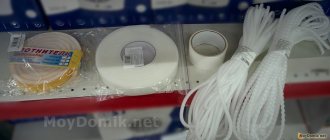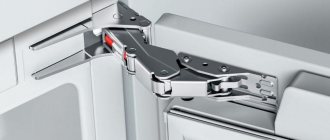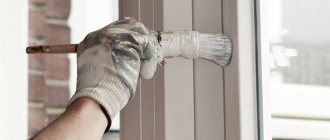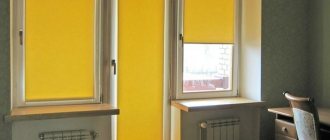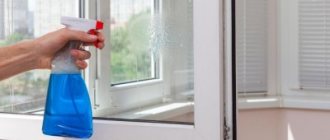To eliminate malfunctions, you need to adjust the plastic windows. To do this, you can call specialists, or you can do everything yourself, following the instructions.
A prerequisite for the effective performance of the functions of a plastic window is correct adjustment. It maintains the tightness of the rebate, the necessary tightness, and the smooth movement of the sash without distortions or touching the frame. The initial adjustment of plastic windows is carried out by installers during their installation. After this, they should work without defects or irregularities. However, over time, small gaps appear and the sashes begin to sag a little. In the future, these deviations intensify, which interferes with the normal operation of the structure.
What tools will you need?
To adjust plastic windows yourself, you will need a fairly simple kit, including:
- Hex wrench No. 4;
- Pliers;
- Phillips and flat screwdrivers;
- A screwdriver with a set of bits of different shapes.
The tools from this set are usually always available at home. An exception may be a hexagon, without which the work cannot be completed - this is the main regulatory tool. If you don’t know what key is needed to adjust plastic windows and where you can find it, then contact any furniture hardware store. 4 mm hexagons are used when assembling any modern cabinet furniture, so finding such a key will not be a problem.
A screwdriver and screwdrivers will be needed to work with the screw connections with which the hardware elements are attached to the profile. Pliers are needed as an auxiliary tool.
It is recommended to additionally prepare silicone grease for the fittings. You can also use WD-40 or other similar spray lubricants.
Main components that need adjustment
Adjustment may be required for any moving elements of plastic window fittings, which include:
Bottom swivel hinge
Top hinge with tilt and turn mechanism
Locking pins
Do-it-yourself repair and adjustment of plastic windows may be required at several points. In particular, it may be necessary to adjust the sash vertically, horizontally, adjust its pressure to the frame, and set the lower angle correctly
When do you need to adjust plastic windows?
Adjustment of windows is required in case of any violations of their normal operation. The following signs may indicate the need for its implementation:
- Tight movement of the valves;
- Visible subsidence or distortion of the sashes;
- Violations of the tightness of the closure - cracks appear, blowing from the window;
- Switching modes is difficult;
- Loose or jammed handles;
If such signs are detected, it is not recommended to delay taking action. In most cases, you can adjust the plastic windows yourself and quickly restore their normal operation. If you do not make adjustments in a timely manner, soon enough you may encounter a serious malfunction of the window structure, which will cause a lot of inconvenience and require significant repair costs.
Possible consequences of incorrect settings
The biggest trouble with incorrect adjustment is wide gaps through which it will leak. In the cold season, this is fraught with heat loss, which should not be allowed.
A distortion of the structure will lead to incorrect operation of the hinges, which, in turn, leads to their failure. This can also lead to damage to the window sill - traces of the affected profile will remain on it.
But you should not treat the adjustment as an operation with simple manipulations. Any movement can change the settings. And although the process itself is simple, it must be approached with great care.
Did you know that plastic windows can be adjusted this way? Perhaps you have already encountered such a process? Tell us in the comments. Save the article to bookmarks and share it on social networks.
Adjusting the pressure of a plastic window
Most often you have to adjust the pressure on the sash of a plastic window. This parameter characterizes the force with which the sash is pressed against the frame when closed. Pressing of the sash is ensured by locking trunnions located at its end part. When the handle is turned, the trunnions move vertically, entering or leaving the mating part located in the frame opening. When the axle completely extends beyond the mate, the sash is pressed against the frame with maximum force. The magnitude of this force is subject to adjustment.
It is recommended to adjust the pressure of plastic windows at least twice a year to switch to winter and summer mode. The maximum pressure is set for the winter. It provides increased tightness and prevents cold air from entering the room due to insufficient sash cover. However, strong pressure accelerates the wear of rubber seals, so it is recommended to loosen it in summer.
It is also necessary to adjust the pressure of the plastic window if there is a blow from the area where the sash adjoins the frame. The reason for this may be incorrectly adjusted pressure or wear of the seals. You can check the presence of draft using the flame of a match or a lighter brought to the window. If the flame fluctuates, adjustment is necessary.
The plastic window does not close tightly - how to adjust
To ensure that the sash closes tightly, you can adjust the pressure of plastic windows yourself according to the instructions.
The axle has an eccentric that needs to be turned in a certain direction to adjust the pressure of the PVC window. Depending on the model of fittings used, there are oval or cylindrical trunnions. In the first case, the adjustment is performed by turning the trunnion itself with pliers. When the oval is positioned in a vertical position, the minimum clamping force is ensured, and in a vertical position, the maximum is ensured.
More popular today are cylindrical pins, which have sockets at the end for a No. 4 hex wrench offset from the axis by 2 mm. In this case, you can adjust the pressure of the plastic window by turning the pin using a hex key. Turning to the left increases the pressure, and turning to the right weakens it. Maximum pressing is achieved when the eccentric is positioned in such a way that the key socket is located on the outer side of the sash. The minimum pressure is achieved in the reverse position of the eccentric - the key socket is located on the inside of the sash.
Another eccentric is located on the underside of the top hinge plate. It must be rotated similarly to the eccentrics of the trunnions around the perimeter of the sash. This will allow you to adjust the pressure in the top hinge area. To access this eccentric, the window must be open in two positions. First, you need to open the sash and switch it to ventilation mode by pressing the lock lever.
To evenly press the sash around the perimeter, all eccentrics on the trunnions must be in the same position. Uneven pressing accelerates wear of the seal and leads to a violation of the tightness of the closed window.
Tips and tricks - how to do everything right
Adjustment of double-glazed windows made from PVC should be carried out in accordance with the following recommendations:
It is necessary to fully examine the end side of the sash, since this is the most important part of the window; cylindrical elements are located on it. As the sash moves in space, it enters the window frame and is securely fixed by means of the specified cylindrical mechanisms. After examining the end and identifying all structures that require adjustment, you can proceed directly to regulation.
At the end you can see two semicircular elements, which, along with the clamps, are also responsible for the tightness. To insulate the room, both semicircles should be turned towards the street, which will increase the pressure of the sash against the frame.
These same strips can also be used to adjust windows back when warmer weather arrives. We turn the semicircular mechanisms towards the room, a small gap will appear between the doors, necessary for the movement of air masses between the apartment and the street.
How to adjust a plastic window so it doesn't blow
In some cases, adjusting the window trunnion does not allow achieving the tightest possible pressure, and the closed sash continues to blow. This occurs when the sash moves vertically or horizontally. As a result, part of the trunnions may not completely extend beyond the mating part.
To determine the place where incomplete pressure is created, you need to remember the locations of the trunnions or make corresponding marks on the inside of the sash profile. After this, you need to close the window and, in the marked places, try to press the sash away from the frame with your hands. If it remains motionless, then the trunnion is working properly. If the sash moves, and a gap appears at the point where the force is applied, then the trunnion does not completely fit into the mating part. In such cases, additional adjustment of the plastic window sash horizontally and/or vertically is required.
Adjusting the plastic window horizontally
To eliminate slight distortion and displacement of the sash in the horizontal plane, you need to adjust the plastic window horizontally. This adjustment can be made on the upper and lower hinges, which have special hexagon sockets. Therefore, you can adjust the position of the sash using the same 4 mm hex key that was used to adjust the trunnions on plastic windows.
On the bottom hinge, access to the hexagon socket is available from the outside and inside. Thanks to this, you can adjust the window both open and closed. When you turn the key clockwise, the sash will move in the direction opposite to the hinge, while its lower corner on this side will rise. Turning the key counterclockwise causes the sash to move towards the hinge, and the lower corner on the opposite side is slightly lowered.
Horizontal adjustment of the plastic window sash can also be done on the top hinge. In this case, work is carried out only with the window open. On the hinge you need to find the hexagon socket and turn it with a key in the same way as working with the lower hinge.
These manipulations will allow you to move the upper or lower part of the sash horizontally up to 2 mm. It is recommended to adjust the sash with limited displacements - no more than 1 mm per turn of the key.
Adjusting the plastic window vertically
Self-adjustment of plastic windows vertically is performed on the lower hinge. The required hexagon hole is located at the top of the hinge, so to access it you need to remove the decorative plastic cap. For ease of adjustment, it is recommended to switch the window to ventilation mode. Turning the key clockwise raises the sash, and counterclockwise causes it to lower.
As with the horizontal adjustment, the window sash movement range is 2 mm.
The top right corner doesn't close
In cases where the corner of the sash located above the handle does not close, the reasons are completely different and the window needs to be adjusted. In old windows, the window sash sags and the pins touch the bar. This malfunction is accompanied by a knocking sound when the window is closed. The window sash may become jammed. How to properly adjust a window must be decided immediately after inspecting the window structure, since there are many varieties. In some cases, moving the bar itself helps. It can be adjusted through the oval holes above the screws.
When using roto nt fittings, adjust the flap height.
It happens that the loop itself is faulty if it turns. For this reason, she cannot press the corner of the plastic window. Such loops are found in Aubi. You can turn the loop back to its original state, but this will not solve the problem, but will only postpone its solution for a short time. Feel free to switch to a different brand of hardware as Aubi is no longer in production. The highest quality fittings - Roto or Maco - are produced in Germany.
Replacing the handle and adjusting the fittings of a plastic window
In addition to insufficient pressure and airflow, other problems may arise in the operation of a plastic window. Often during operation, problems may arise with turning the handle, which moves slowly when switching modes or even gets stuck in a certain position. Therefore, owners need to know how to properly adjust plastic windows themselves in such cases.
One of the common causes of such problems is a faulty handle. Most often it just becomes loose and starts to wobble. In case of such a malfunction, it is enough to tighten the fastening screws. To access the screws, you need to pry the decorative plastic trim on the handle body from above and below with your fingers and turn it horizontally.
Stiffness of the handle can be caused by clogging of its mechanism. To remove dirt, the handle must be removed by unscrewing the fastening screws and cleaned with a brush or vacuum cleaner. It is recommended to lubricate the seat of the handle inside the door with WD-40 aerosol lubricant with a nozzle. Another reason why the handle turns tightly may be that the sash is being pressed tightly. If it is not necessary to maintain maximum pressure, it is recommended to adjust the trunnions by reducing the force.
If the handle does not turn at all, this is most often due to incorrect operation of the lock, which is designed to prevent it from turning when the sash is open. To unlock the handle, you need to find the lock and release it. Depending on the model of fittings used, the blocker can be made in the form of a clip that fits onto the seal, or in the form of a shaped plate screwed at an angle to the seal.
The solution to the problem in case of severe wear is to replace the handle. You can find a new part in almost any hardware store or order it from a window manufacturing company. All handles have a standard design, so there will be no problems with selecting a suitable element. After this, you just need to dismantle the old handle and put a new one in its place.
The plastic window closes tightly - how to adjust
If the plastic window does not close well, self-adjustment will also help eliminate the problem. The reason is usually the misalignment of the sash, as a result of which it touches the frame when opening or closing. To solve the problem, you need to eliminate the skew by adjusting vertically or horizontally. First of all, you need to carefully inspect the window to determine the place where the sash comes into contact with the frame. Contact between surfaces usually occurs on the bottom edge or on the side edge of the sash on the side opposite the hinges.
If the sash rubs the frame from below, it must be moved up and towards the corner adjacent to the top hinge. To adjust a metal-plastic window with your own hands, you need to open the sash and turn the adjusting screw of the top hinge clockwise a few turns. After this, you need to close the sash, remove the decorative cap from the lower hinge, insert the hex key into the hole of the adjusting lift and turn it several turns clockwise. After adjusting the PVC window, you need to check the movement of the sash. If necessary, repeat the manipulations.
If the sash comes into contact with the frame when opening and closing, then adjusting the fittings of a plastic window with your own hands involves moving it towards the hinges. If there is friction only on the lower side of the side edge, it will be enough to tighten the adjusting screw, which is located in the lower part of the lower hinge on the side, with a hex wrench. If the sash rubs the frame along the entire height of the side surface, then it must be moved additionally towards the upper hinge. To do this, you will have to tighten the adjusting screws on both hinges. After completing the work, you need to check the movement of the sash. If its friction on the frame is not completely eliminated, the adjustment manipulations must be repeated.
Deformation of the window profile due to shrinkage
It is almost impossible to eliminate sagging on your own. Contact the service department with a request to reinstall the structure. As a rule, the manufacturing company provides a guarantee for window products and the work performed to install them.
However, if the window is irrevocably deformed, you will have to buy a new one. The problem is typical for new buildings, where the walls have been recently erected and the house has not yet completely gone through the shrinkage stage. Only after the wall movements have been completed can you begin to re-install PVC windows.
PVC window lubrication
A significant part of the violations that require adjustment of the mechanism of plastic windows occurs due to its poor lubrication. In new windows, the fittings are coated with a sufficient amount of lubricant for effective operation. However, over time, these compounds degrade and lose their properties. These processes occur especially intensively in houses that are located near busy highways, industrial enterprises, and other sources of air pollution. Dust settles on the moving elements of window fittings and penetrates the lubricant, which significantly deteriorates its quality. This leads to jamming of the mechanisms and their accelerated wear. Therefore, adjusting old plastic windows always involves lubricating them.
To prevent accelerated wear of fittings and complex repairs, you need to lubricate them at least once a year. It is best to lubricate windows twice a year - before the onset of the winter and summer seasons. In addition, it is recommended to lubricate after carrying out any maintenance work on any hardware elements, for example, after adjusting the scissors of a plastic window, hinges or pins.
What to lubricate with?
Special compounds are used as lubricants for servicing plastic windows, which are sold in specialized stores or can be ordered from window suppliers. They are supplied in bottles with convenient attachments designed to work with certain elements of fittings. If such special lubricants are not at hand, you can use technical petroleum jelly and any technical oils, for example, sewing machine oil. Silicone grease or aerosol lubricants such as WD-40 can also be used. The use of edible, cosmetic and other types of oils that are not intended for use with mechanisms is not allowed.
To achieve maximum beneficial effect, the lubricant should be applied to clean and dry metal surfaces. Therefore, after adjusting the window fittings, it must be thoroughly cleaned of any dirt and wiped with a soft cloth. Dirt from hard-to-reach places is removed with a brush or sponge. Before applying the lubricant, it is recommended to further inspect the window fittings to ensure they are clean.
What to lubricate?
Lubricant is applied to all moving elements. Lubricated including:
- Trunnions;
- “Scissors” of a plastic window;
- Hinge adjustment mechanisms;
- Fastenings;
- Latches, etc.
A few drops of lubricant are applied to each of the moving parts. After this, I let the mechanism work in normal mode to distribute the lubricant evenly.
In addition to the mechanisms, rubber seals must be lubricated. For this, a special composition is used. The lubricant maintains the elasticity of the rubber and prevents it from drying out. It is better to treat seals twice a year. Be sure to lubricate them in the fall when adjusting the pressure of a plastic window with your own hands in winter mode.
Regular lubrication of window fittings will extend its service life and eliminate unnecessary repairs and adjustments. In some cases, it serves as an alternative to adjustment work. For example, before adjusting plastic windows that do not close well, it is recommended to lubricate the fittings. In many cases, this is enough to solve the problem.
A few important points
- Do not try to turn the trunnion all the way, it does not have such a position. Focus on the position of the eccentric. In winter mode, the notches are located vertically, in summer mode - horizontally.
- If you can’t turn the trunnions, you don’t need to try to do it with extreme force. Try pulling the eccentrics towards you; perhaps you have the type of fittings described in paragraph 3. If it doesn’t work out, it’s better to invite a specialist. Otherwise, you can damage the entire system.
- Remember to return the setting to medium or summer mode in the spring to reduce wear on the seal.
If you find that your windows are not performing their functions due to long service life or poor quality and it’s time to change them, RealPlast will be happy to help you with this!
